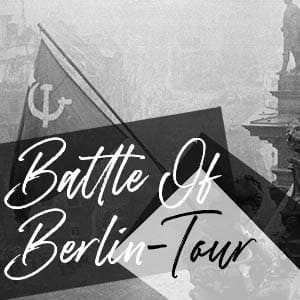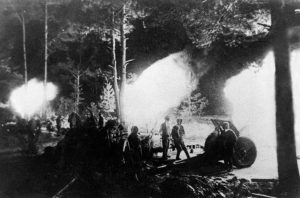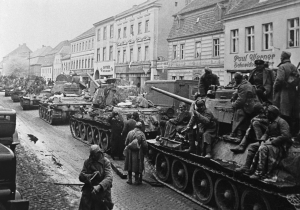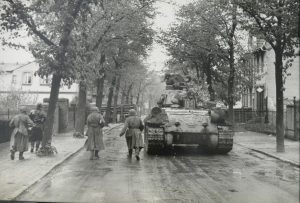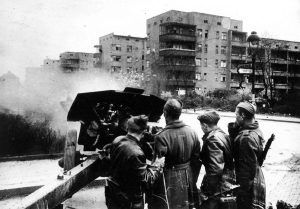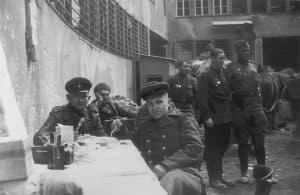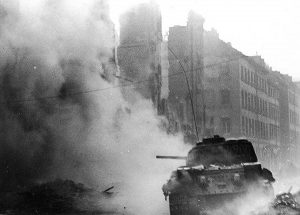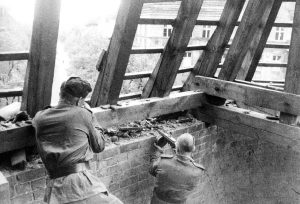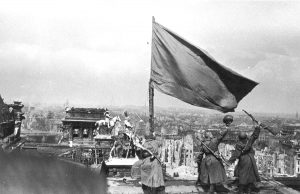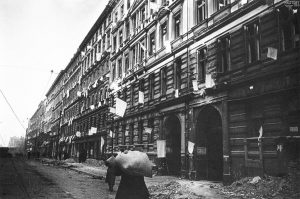In the early hours of April 29th, Nazi leader Adolf Hitler married his long-term mistress, Eva Braun, in a ceremony conducted in his underground Führerbunker.
The young photographer’s assistant from Bavaria had been by his side, but kept out of the public eye, since 1931 – and would remain with him in the bunker until the end.
The ceremony would only last around ten minutes, and be carried out in the presence of Propaganda Minister Goebbels and Head of the Nazi Party Chancellery Bormann.
There were no female witnesses.
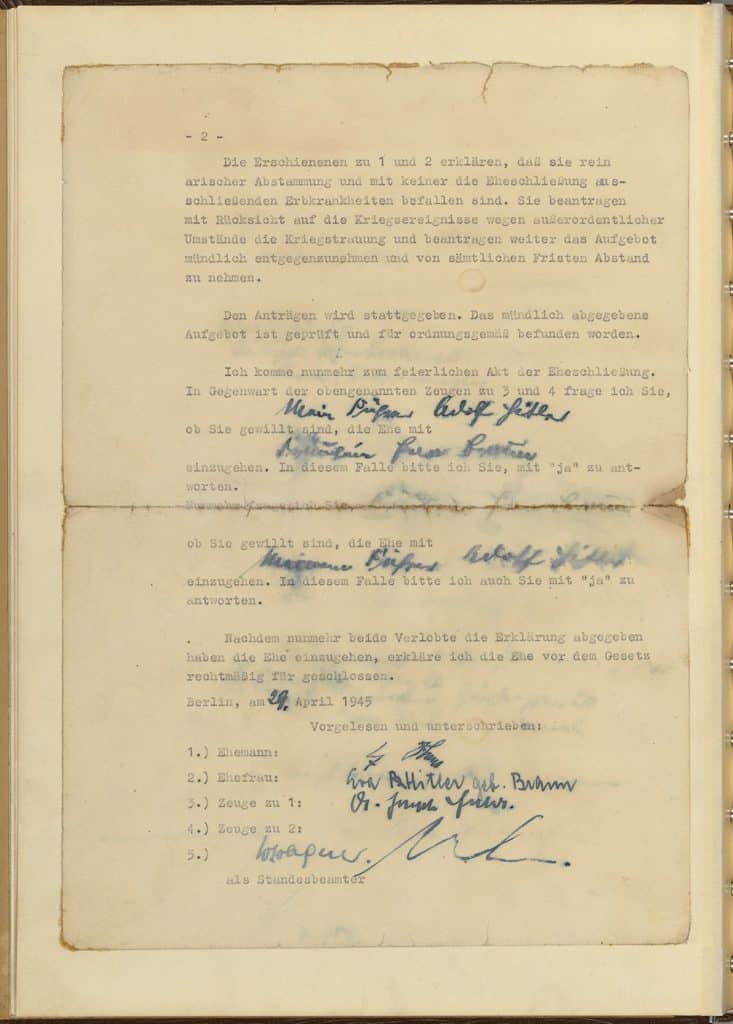
Before the wedding, Hitler had already dictated his personal and political wills to his secretary, Traudl Junge, and would return to impatiently oversee Junge transcribing her shorthand notes immediately after the ceremony.
Describing his grim intentions for married life, Hitler would announce:
“I myself and my wife – in order to escape the disgrace of deposition or capitulation – choose death. It is our wish to be burnt immediately on the spot where I have carried out the greatest part of my daily work in the course of twelve years’ service to my people.”
According to Junge she was then asked by Hitler to take note of his final political testament. In it he would decry that he never intended to be faced with war in 1939, blaming instead Jewish interests for the subsequent carnage. Closing the first part of his political testament, Hitler again outlined his intention to end his life, saying: “I have therefore decided to stay in Berlin and there to choose death voluntarily when I determine that the position of the Führer and the Chancellery itself can no longer be maintained.”
Once typed out, Hitler’s political testament would be signed by four witnesses – Goebbels, Bormann, and Generals Burgdorf and Krebs – and distributed to three messengers. One copy to be sent to Admiral Dönitz, one to Marshal Schörner, head of Army Group Centre, and the other to the headquarters of the Nazi party in Munich.
Returning to the former German system of President and Chancellor – with no room for another Führer – Hitler designated Admiral Dönitz as Reichspresident and Joseph Goebbels as Chancellor.
Shortly afterwards, Hitler retired to his quarters with his new wife, as his secretary, Traudl Junge, was left to finish typing Joseph Goebbels’ testament.
Goebbels’ and his wife Magda would conspire to murder their six children before committing suicide on May 1st, with Junge would later saying of the children:
“they knew nothing of the fate awaiting them, and the adults did all they could to keep them unaware of it.”

At 10am, a Hitler Youth runner appeared at the upper bunker of the New Reich Chancellery to report that Soviet tanks were now only 500m from the building. Thirty minutes later, the air balloon supporting radio-telephone communications between the bunker and army headquarters was shot down.
Ending all telephone communication between the bunker and the outside world.
With fighting in the city now largely condensed into a sausage-shaped area extending from Alexanderplatz to the banks of the Havel in the West – and German control barely a mile wide in places – Berlin Defence Area Commandant General Weidling was fighting a losing battle. Around 30,000 men were estimated to remain of the fighting force, with ammunition dwindling and supplies running out fast, Weidling concluded that the defenders could only hold out for another 48 hours at the most.

During the night of April 28th/29th, the Soviet 79th Rifle Corps made preparations for crossing the River Spree at the Möltkebrucke and advancing to capture the Reichstag building. Using heavy tanks to push aside the barricades on the north side of the bridge, infantry attempted to carry out a surprise attack just after midnight – unheralded by any artillery barrage.
Caught in a hail of fire from the enfiladed machine guns and blasted by mortars that had already been zeroed in on the bridge, they were quickly brought to a halt. As the SS Anhalt troops based on the south side of the bridge had also used the night of April 28th to further reinforce their positions.
Another attempt was made by the Soviets to bash through the southern barriers on the bridge using heavy tanks, only to see the advance reduce to twisted metal and fire by the anti-tank guns nearby, the tanks of the SS Hermann von Salza Panzer Battalion, and the supporting fire of the Zoo Flak tower.
The bridge was eventually secured – if only temporarily – by Red Army infantry, who flooded into the Diplomatic Quarter, leaving mounds of bullet riddled corpses in their wake.
A counterattack from the SS would then drive the Soviet troops back across the bridge and be further confused by the unexpected arrival of the German 9th Parachute Division from the Lehrter Railway station. Breaking the Soviet lines from the north, these troops would cross the bridge to the south and bring with them around 100 reinforcements for the battle.
At around 7am, the Soviet 150th Rifle Division prepared to cross the bridge and take the two buildings of the Ministry of the Interior – dubbed the ‘Himmler House’ – after a ten minute artillery barrage. The troops fought their way across the Möltebrucke under heavy fire, leaving the remaining attackers to throw grenades into the building interior, starting fires as the carpets and furniture burned, and filling the building with smoke that would both aid and hinder their advance. It would take the rest of the day before the buildings were secured.

Across to the east side of Defence Zone Zitadelle, the 5th Shock Army spent the day fighting strong resistance from Waffen SS troops, moving to take the Börse train station (now Hackescher Markt) and the Rotes Rathaus, the red brick city hall. Fighting in the Police Presidium at Alexanderplatz would eventually stop at around 3pm – but only after some of the most brutal room-to-room combat in the city.
For the first time in the battle of Berlin, the SS and Gestapo Headquarters on Prinz-Albrecht-Strasse (today Niederkirchnerstraße) came under attack, from the 301st Rifle Division. The officials still located there having organised themselves into a group of desperate defenders.
Colonel-General Vasiliy Chuikov’s attack by the 8th Guards Army was scheduled to begin across the Landwehr Canal, in an arc extending from the Bendlerblock army headquarters to Hallechers Tor, on April 29th.
Among the soldiers gathered for the assault was the standard bearer of the 220th Guards Rifle Regiment, Sergeant Nikolai Masalov. In the quiet before the opening artillery barrage, Masalov heard the crying of a three year old German girl on the opposite side of the canal. He managed to crawl across under covering fire from his comrades and rescue the girl, lying in rubble next to her dead mother.
His deeds would be immortalised in a giant statue of a Soviet soldier saving a child in the Soviet War Memorial in Treptower Park – constructed after the Battle of Berlin to commemorate 7,000 of the more than 80,000 soldiers who would die fighting to take the Nazi capital.
Despite the rush to the Reichstag and the emphasis on Berlin’s central historic district, fighting on April 29th continued in the west, particularly on the boundary of Kantstrasse – as the 3rd Guard Tank Army held control of Westend and were struggling along Kaiserdamm further north while pushing deeper into the city and the Tiergarten central park.

Soviet armour would eventually cross the Potsdamer Bridge on April 29th – utilising an unusual method. Frequently falling victim to the armed groups of Hitler Youth that would hunt Soviet tanks with Panzerfaust anti-tank weapons, crews had taken to attaching bedsprings and sandbags to the side of their vehicles. In the hopes that these objects would deflect the projectiles.
After infantry struggled to cross the Potsdamer Bridge and tanks were being knocked out one by one by a dug-in Tiger tank covering the crossing, someone had the idea to cover the protective coating of the next tank in the line with oil and smoke canisters. When it burst into flames on the bridge, the defenders were quick to conclude that it had been disabled, paying little attention to it careering forward across the bridge and into their fortifications.
Only then did they realise that the tank was still very much alive and had secured enough cover for the infantry to then cross and overwhelm the defenders.
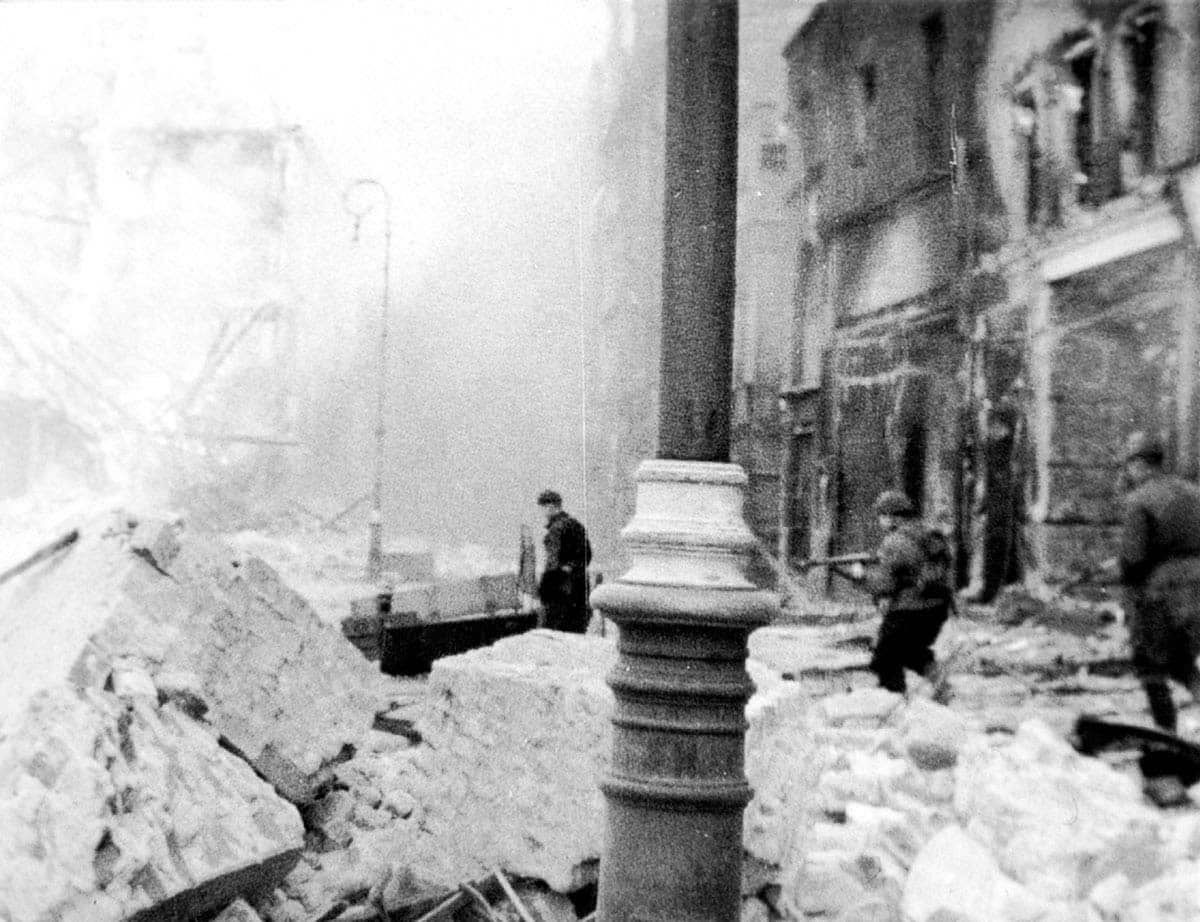
When Soviet troops of the 1st Mechanised Corps finally crossed the river Spree and reached the Charlottenburg Palace on April 29th 1945, they found little of the former glory of Prussia. This once magnificent royal residence had been considerably damaged by Allied air raids in November 1943 and February 1945.
Dating back to the 17th century, Schloss Charlottenburg had served as a summer residence for Berlin’s ruling Hohenzollern royal family, built for queen Sophie Charlotte by her husband – Frederick I – then the elector of Brandenburg. The man destined to become the first Prussian king in 1701.
Beyond the extensive gardens influenced by the work of André Le Nôtre, landscape architect for the park of the palace of Versaille, and the mausoleum constructed to house the first German Emperor, Wilhelm I, and his wife Augusta – this fairytale residence previously housed what was referred to locally as the ‘eight wonder of the world’. A chamber decorated in amber panels backed with gold leaf and mirrors – the famous Prussian ‘Amber Room’.
No longer part of the palace, it was given to Tsar Peter the Great of Russia in 1716. Looted during the Second World War from its home in the Catherine Palace in St Petersburg, its whereabouts remain unknown. Although it was last seen in April 1945 in the city of Königsberg (now Kaliningrad).
A symbol of Prussian-Russian friendship – lost in the pursuit of glory.
–
Back in the Führerbunker, at around 10pm on April 29th 1945, Adolf Hitler received word of the fate of his friend and ally, Benito Mussolini. News of Mussolini’s death at the hands of Italian partisans would arrive in the form of a transcript of a radio broadcast reportedly accidentally picked up by an orderly who was trying to tune a shortwave radio.
Hitler’s valet, Heinz Linge, would note that having read through the text, the Nazi leader would take a pen and underline three words referencing Mussolini’s condition:
‘HANGING UPSIDE DOWN’
**
Our Related Tours
Want to learn more about the Battle of Berlin? Check out our Battle of Berlin tours to explore what remains of this important urban battlefield.
To learn more about the history of Nazi Germany and life in Hitler’s Third Reich, have a look at our Capital Of Tyranny tours.
Bibliography
Beevor, Antony (2003) Berlin: The Downfall 1945 | ISBN 978-0-14-028696-0
Hamilton, Aaron Stephan (2020) Bloody Streets: The Soviet Assault On Berlin | ISBN-13 : 978-1912866137
Kershaw, Ian (2001) Hitler, 1936–1945: Nemesis | ISBN 0-393-04994-9
Le Tissier, Tony (2010) Race for the Reichstag: the 1945 Battle for Berlin | ISBN: 978-1848842304
Le Tissier, Tony(2019) SS Charlemagne: The 33rd Waffen-Grenadier Division of the SS | ISBN: 978-1526756640
Mayo, Jonathan (2016) Hitler’s Last Day: Minute by Minute | ISBN: 978-1780722337
McCormack, David (2017) The Berlin 1945 Battlefield Guide Part I the Battle of the Oder-Neisse | ISBN: 978-1781556078
McCormack, David (2019) The Berlin 1945 Battlefield Guide Part II The Battle of Berlin | ISBN: 978-1781557396
Moorhouse, Roger (2010) Berlin at War | ISBN: 978-0465028559
Ryan, Cornelius (1966) The Last Battle | ISBN 978-0-671-40640-0
Sandner, Harald (2019) Hitler – Das Itinerar, Band IV (Taschenbuch): Aufenthaltsorte und Reisen von 1889 bis 1945 – Band IV: 1940 bis 1945 | ISBN: 978-3957231581
Shirer, William L. The Rise and Fall of the Third Reich | ISBN 978-1451651683.

